Revisiting the fundamentals
Revisiting the fundamentals
Revisiting the fundamentals
Revisiting the basic UX design processes through a social computing platform design for students of Interaction studies.


Revisiting the basic UX design processes through a social computing platform design for students of Interaction studies.
Revisiting the basic UX design processes through a social computing platform design for students of Interaction studies.
Revisiting the basic UX design processes through a social computing platform design for students of Interaction studies.
Overview
Human- Computer Interaction (HCI) areas of study have about 7000 students currently enrolled in the United States. The field has a wide variety of industry it touches and skill areas of specialization. With versatility comes different interpretations/jobs descriptions, skill sets, etc. where sharing of information is mandatory.
Roles: Primary Designer
Duration: 3 months
Team Designer: Enrico Banks, Amy Mansfield
We started by defining the problem space into a HMW statement:
How might we help connect aspiring students of HCI and young professionals with industry professionals for collaborative mentoring?
Process
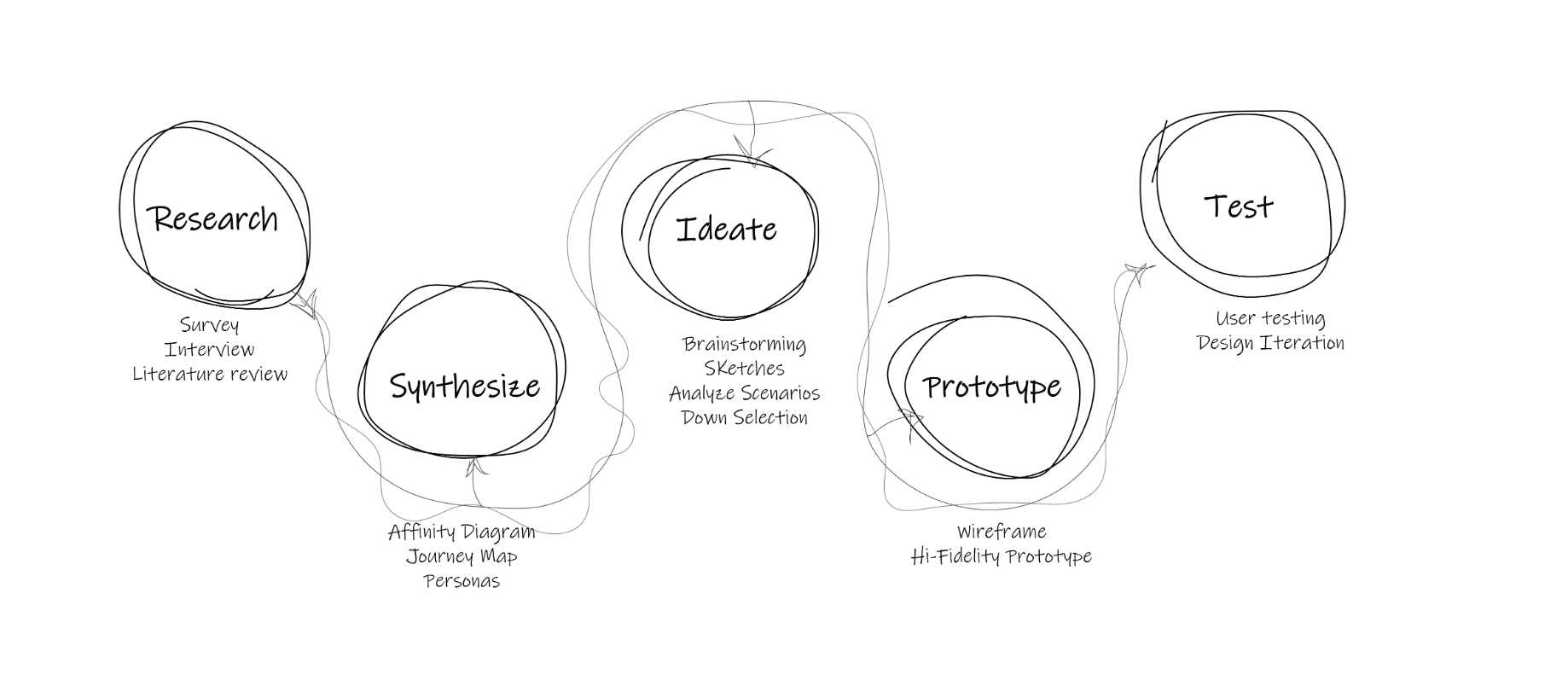
How does mentorship happen on a national scale?
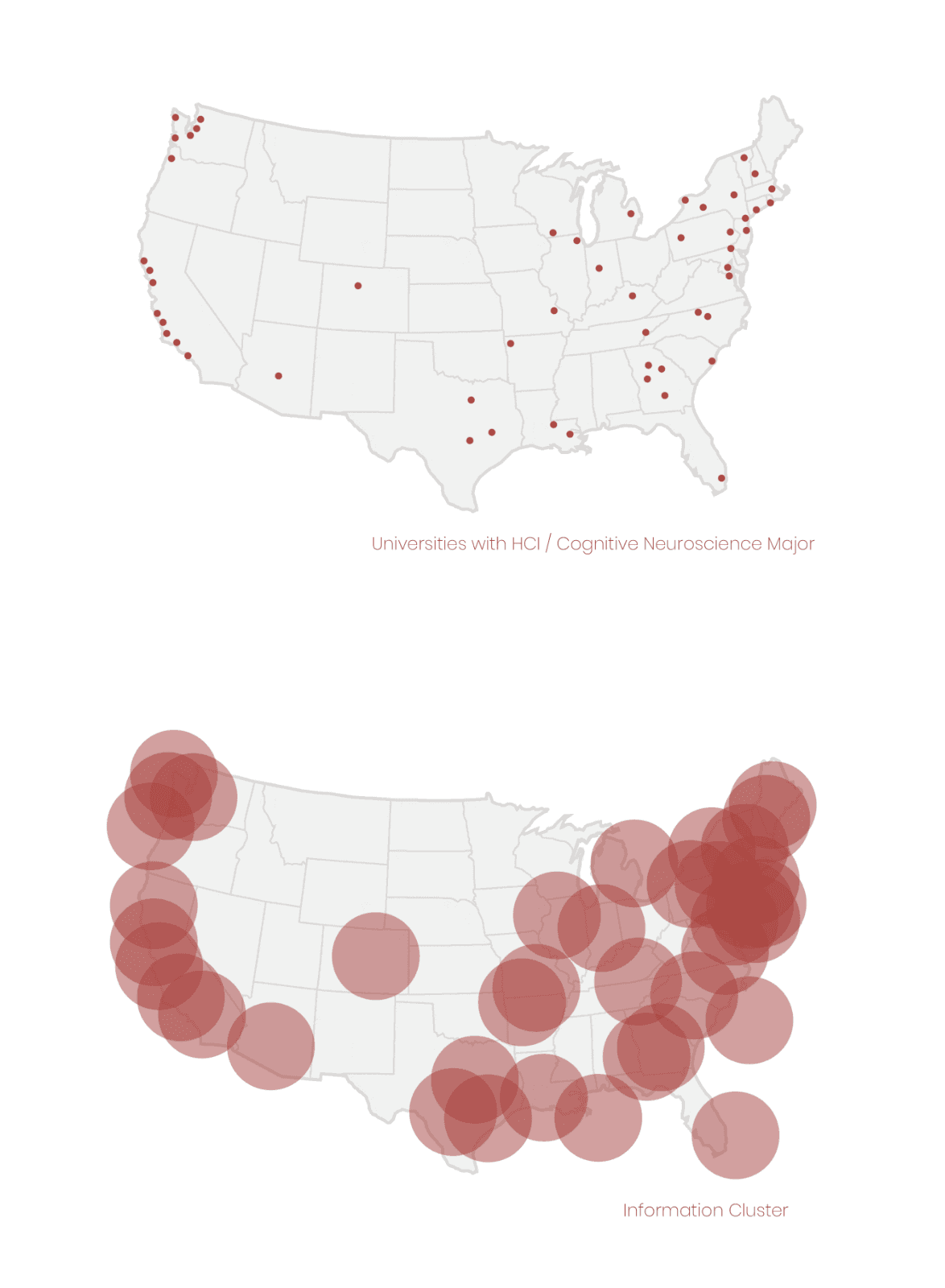
The current way of mentoring is not fulfilling all of the industry needs for good mentoring guidance and knowledge sharing without scheduling or geographic restraints among other barriers. In addition, with the vast amount of information fragmented throughout the website tides, it is important to have a comprehensive platform that compiles the needed information for the aspiring students as well as entry-level professionals to learn and prepare better. This not only does good for young professionals but also their future companies in the long-run.
One-to-One Mentoring
Group Mentoring
Training Based Mentoring
Research Process
Primary Research: Observation & Interviews
To analyze the current scenario of mentoring in the HCI world, we conducted observations and interviews with several mentors and mentees to get in-depth information about their pain points and experience in general.
Secondary Research: Literature Review
To understand the available technology and service to connect mentors & mentees, we started our process of gathering information from various sources to get familiar with the context.
Research Insights
a. Primary Research: Observation & Interviews
Mentors and mentees had various goals, frustrations, and expectations out of mentoring session. The following were thoroughly observed in each case we observed:
b.Secondary Research: Literature Review
Mentees:
1. Frustrations: Mentees with more contacts have better mentoring. But even in that situation, there is a limitation of mentorship
2. Concerns: Concern/ uncertain of the approach in many stages such as introduction, keeping professional information exchange a the primary goal of the session
3. Need: Mentorship is important for efficiency, a better understanding of the current trends, etc.
4. Expectations: Structured mentoring, Availability of Mentors, A collaborative repository to know the present trends
5. Motivations: Giveback, doing the right things
Mentors:
1. Frustration/ Taboo subjects: Mentees asking for a job on the first meet, Personal questions about their personal salary? There need to be an understanding of such taboo questions before the mentorship sessions begin
2. Concern: Time limitations for working mentors
3. Need: Industry-level buy-in
4. Expectation: Structure content & time-sharing, Mentees are expected to do their homework before the meeting
5. Motivation: Giveback, recruiting
Problem Synthesis
Drawing insights from the interviews, observations and literature reviews, we started the synthesis of the problem by creating personas and customer journey maps. This mapped various pain points which inevitably guided us to the solution in the later stages.
Mentee Persona:

Mentor Persona:
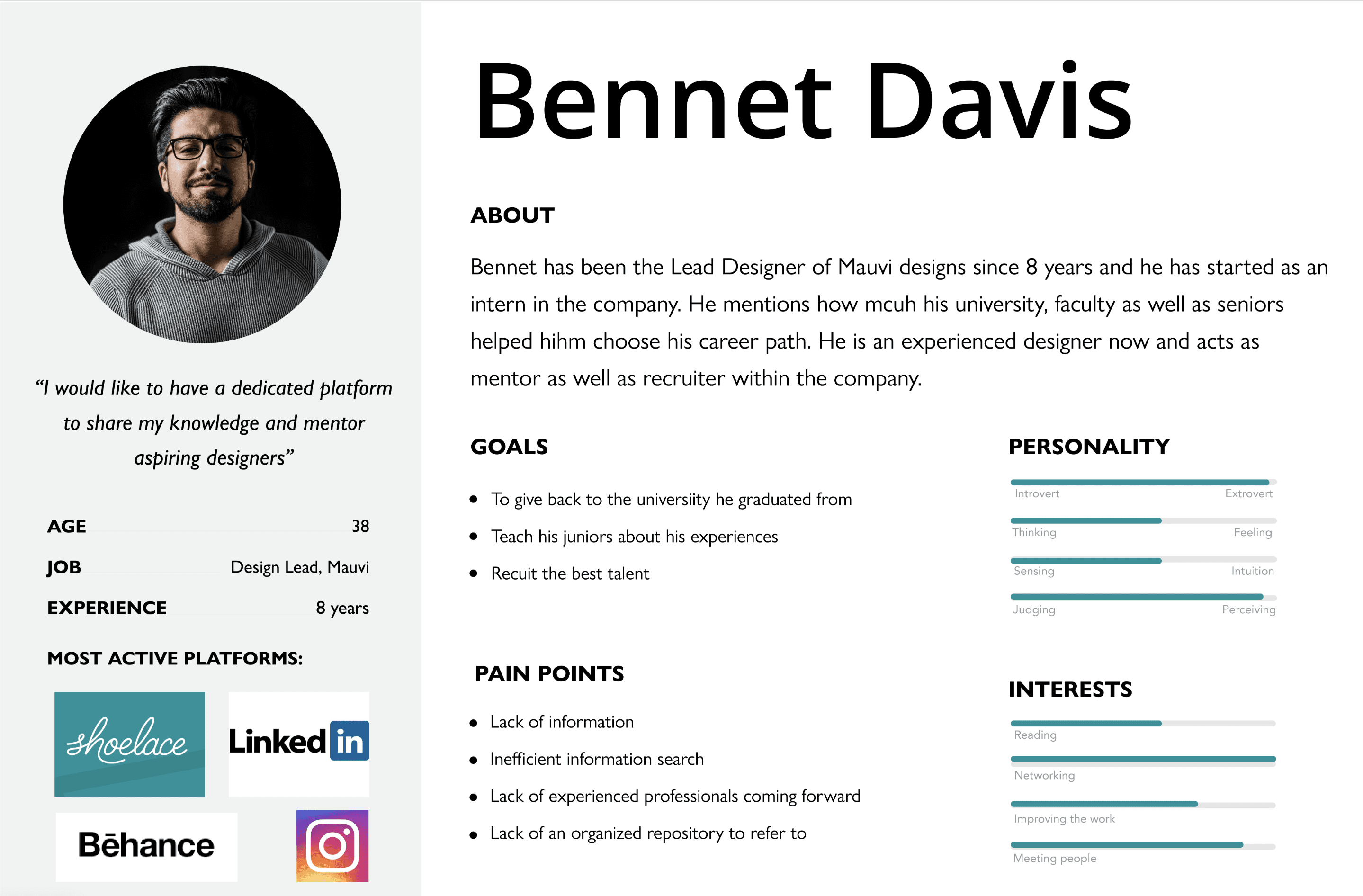
Mentee Journey Map:
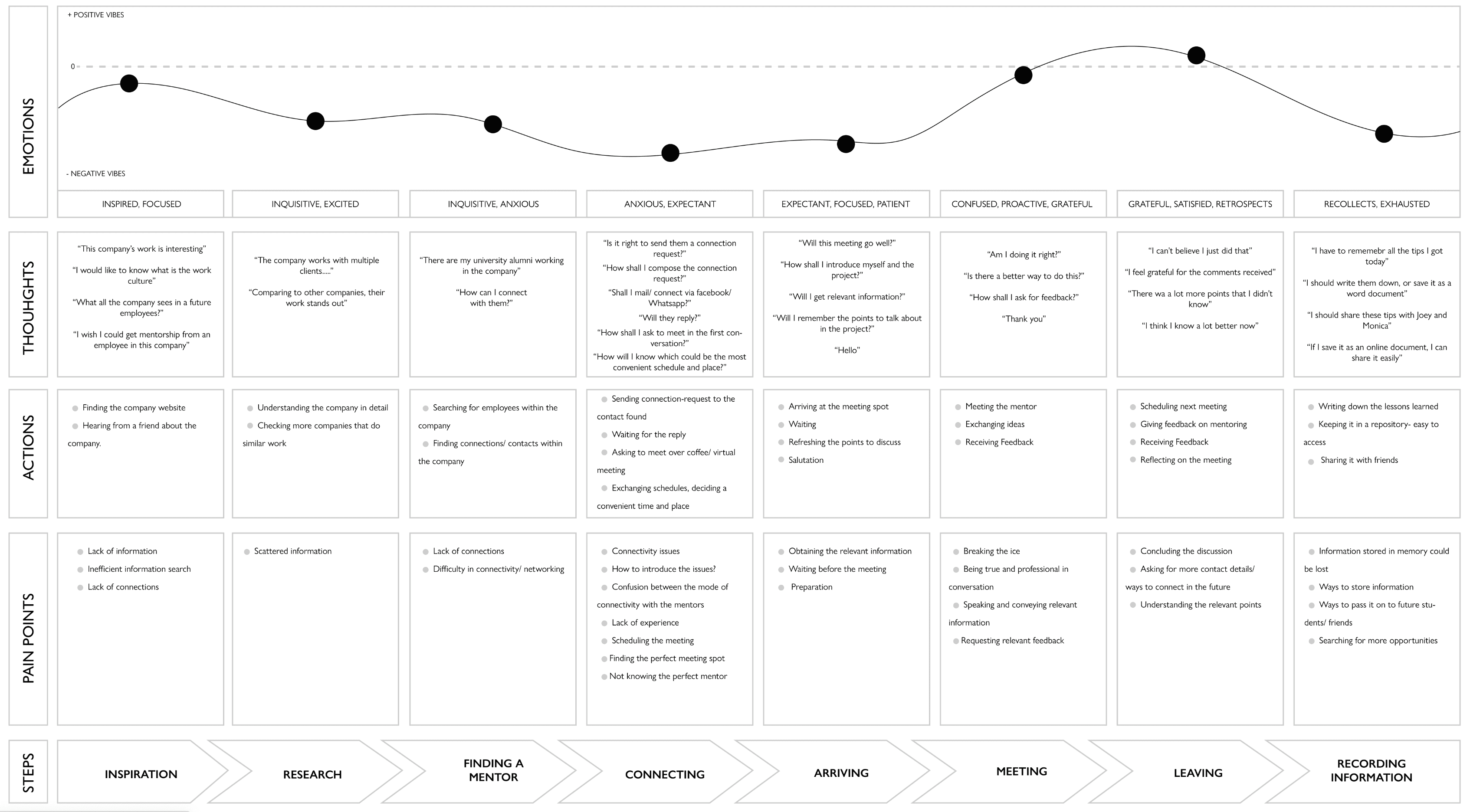
Mentor Journey Map:
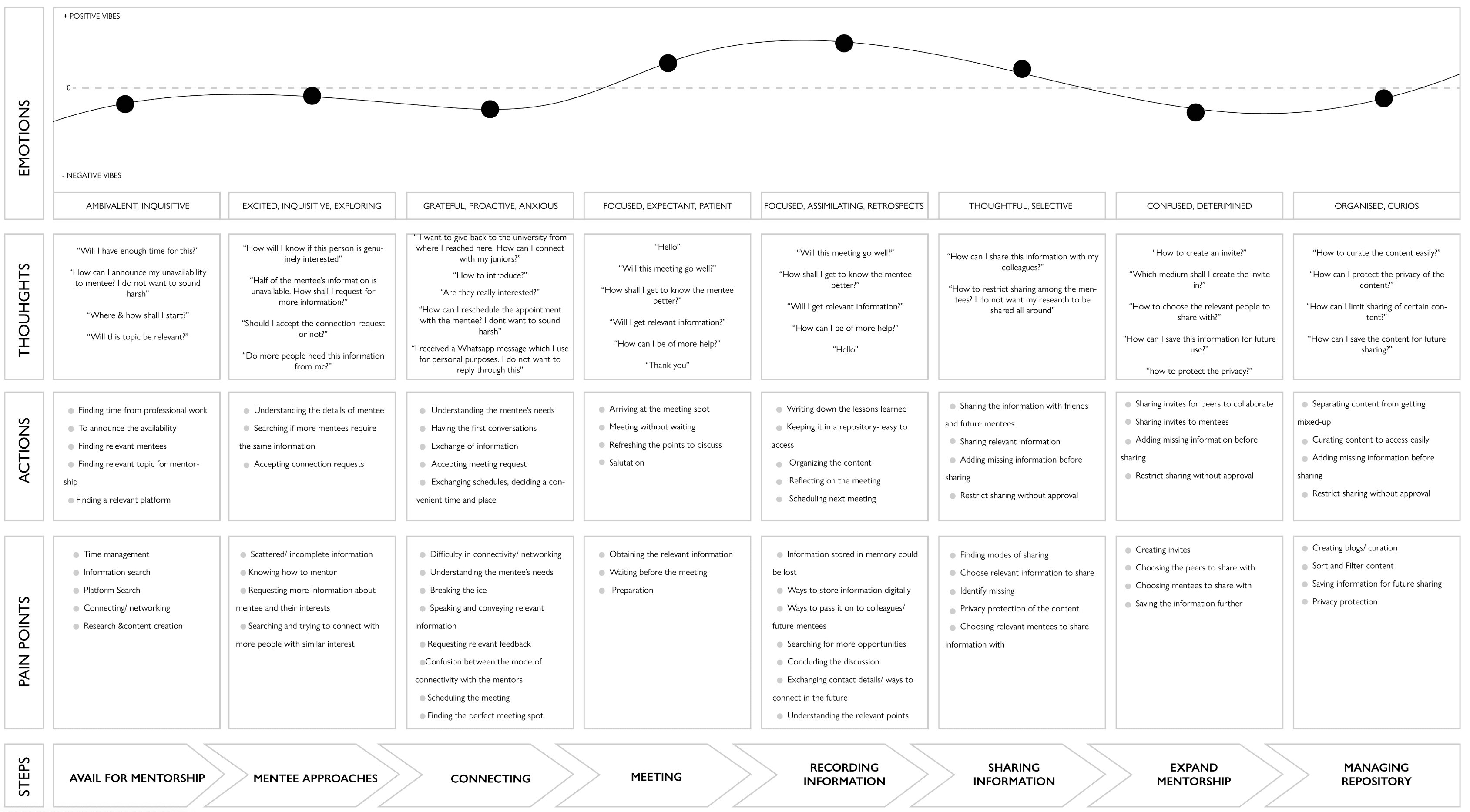
Identifying Pain points:
Mentees:

Mentors:

Prioritizing Pain Points
Given the limited time frame of the class project, we prioritized the pain points referencing it to the user statements where they stressed the most.The major pain points from mentee’s part were:
To analyze the current scenario of mentoring in the HCI world, we conducted observations and interviews with several mentors and mentees to get in-depth information about their pain points and experience in general.
1. Finding a Mentor/ mentorship
2. Confusion between the modes of connectivity
3. Scheduling and finding a perfect meeting spot
4. Recording and storing relevant information in different formats
The most pressing pain points from mentors were:
1. Dedicating time for mentorship
2. Connecting with mentees
3. Avoid taboo subjects(such as to request jobs/ referrals unexpectedly)
4. Curating and sharing the repository of information in any convenient format
Ideating the Solution
We started our ideation phase by brainstorming for various solutions that could fit in at different stages of the mentorship experience. The initial ideas were represented in the form of flowcharts and rough sketches.
Idea #1: Virtual Reality Mentoring Space
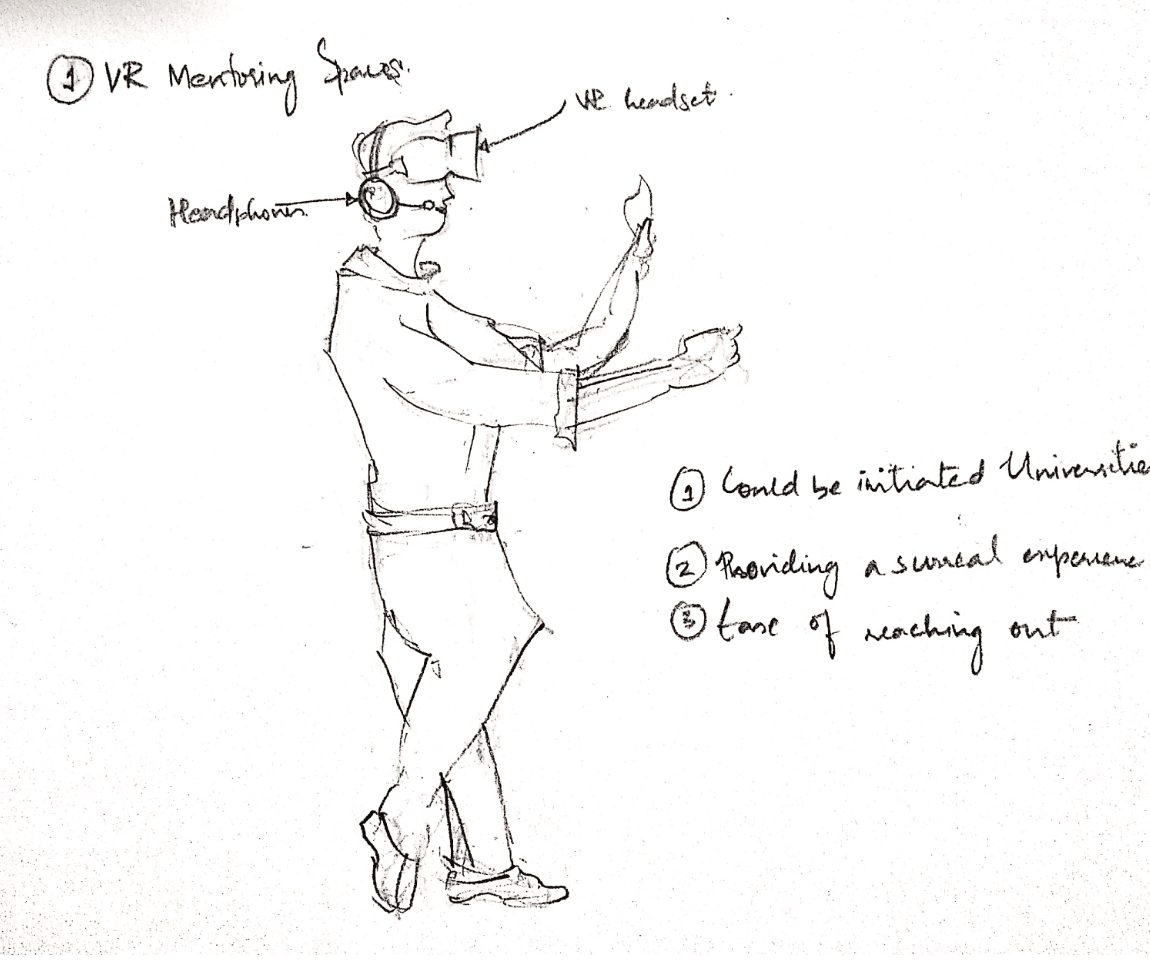
Pros
1. Could be initiated within Universities
2. Providing a surreal experience to the young professional
3. Ease of reaching out
Cons
1. High operational costs
2. Limited expandability
3. The mentor and the mentee requires specific equipment to meet both the endsIdea #2: Mentoring Bots
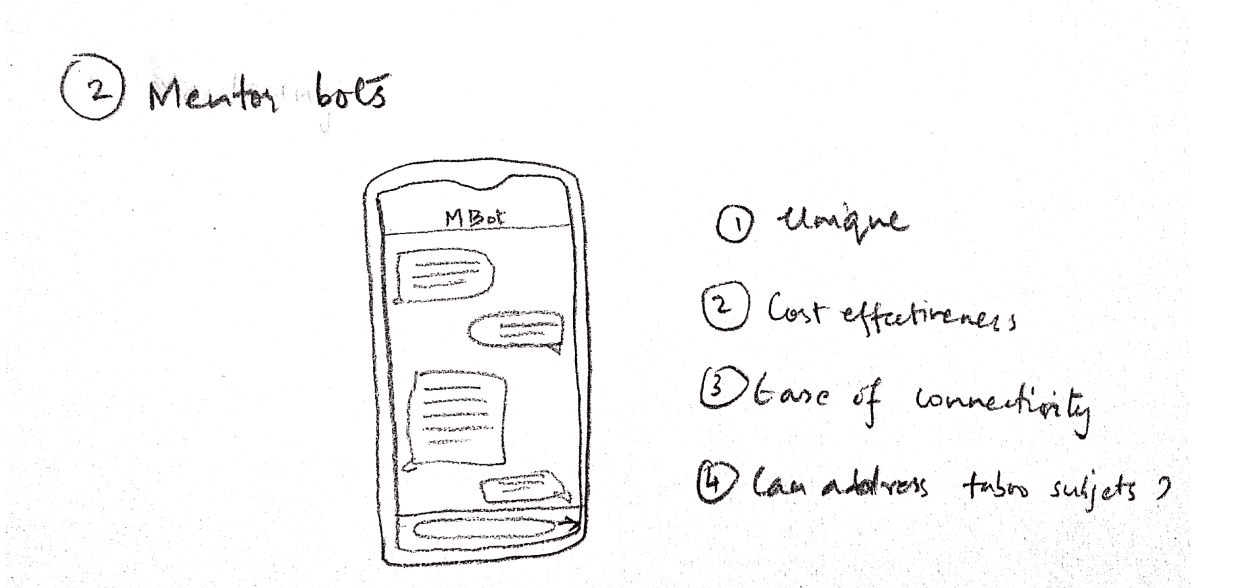
Pros
1. UniqueCost-Effective Solution
2. Ease of connectivity and accessibility
3. Can address/ point out taboo subjects to the mentees
Cons
1. Not really addressing the two-way interaction demanded by the stakeholders
2. Acts as a barrier rather than a conduit to mentoringIdea #3: Social Computing Platform
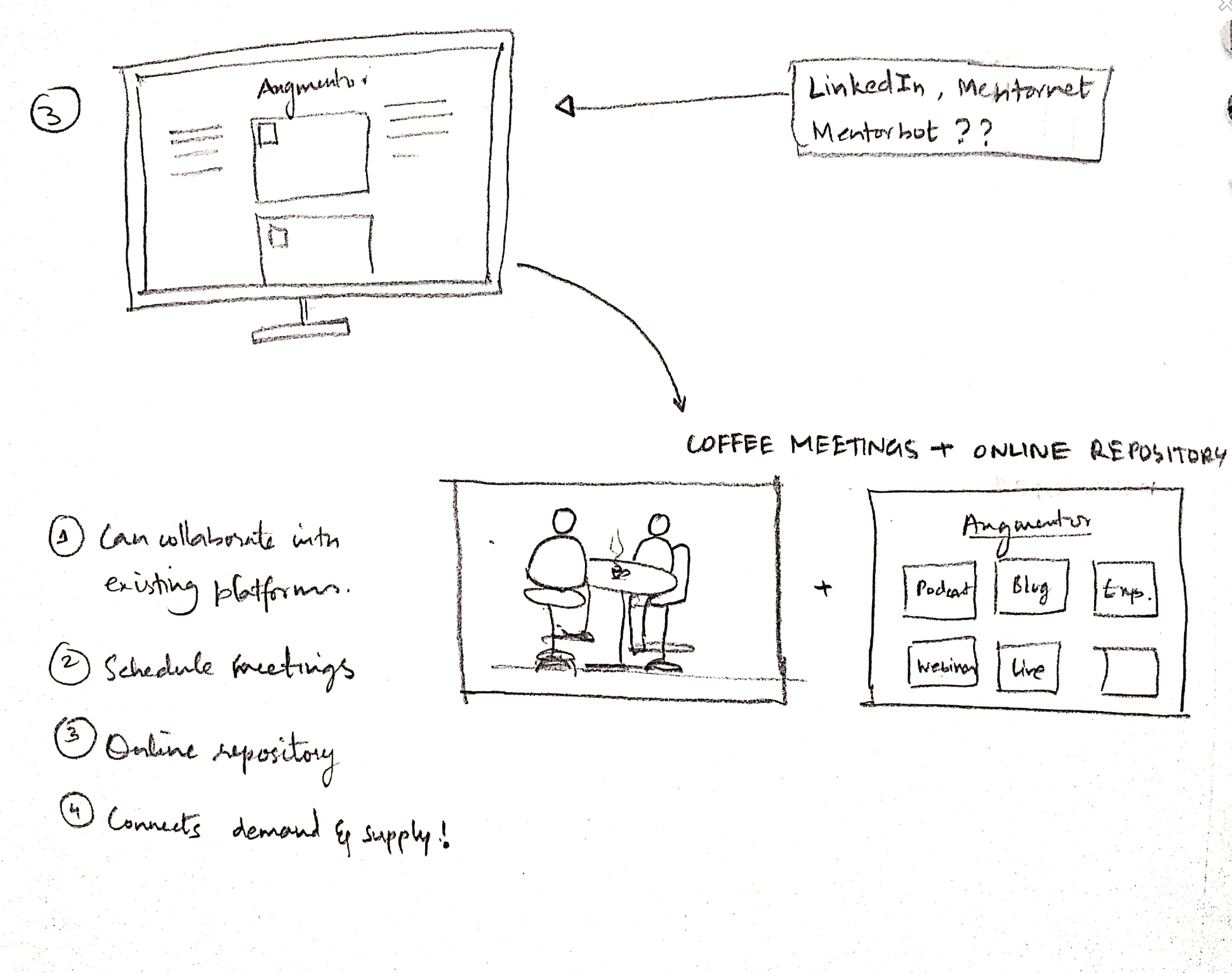
Pros
1. Connects mentors and mentees
2. Can collaborate with existing platforms
3. Scheduling and organizing meetings can be made easy
4. Can host online repository easy to share
5. Cost-effective
Cons
1. Takes time to expand and reach out
2. Has to keep in mind the privacy protection
7. Down Selection Process
Evaluating the pros and cons, my team and I went ahead with the social computing platform. Desirability, Viability & Feasibility matrix was used to evaluate and select the best option.
Desirability — Are We Solving for the Right Pain Points?
Feasibility — Are We Building on our Core Operational Strengths?
Viability — Does Our Solution Contribute to Long-Term Growth?
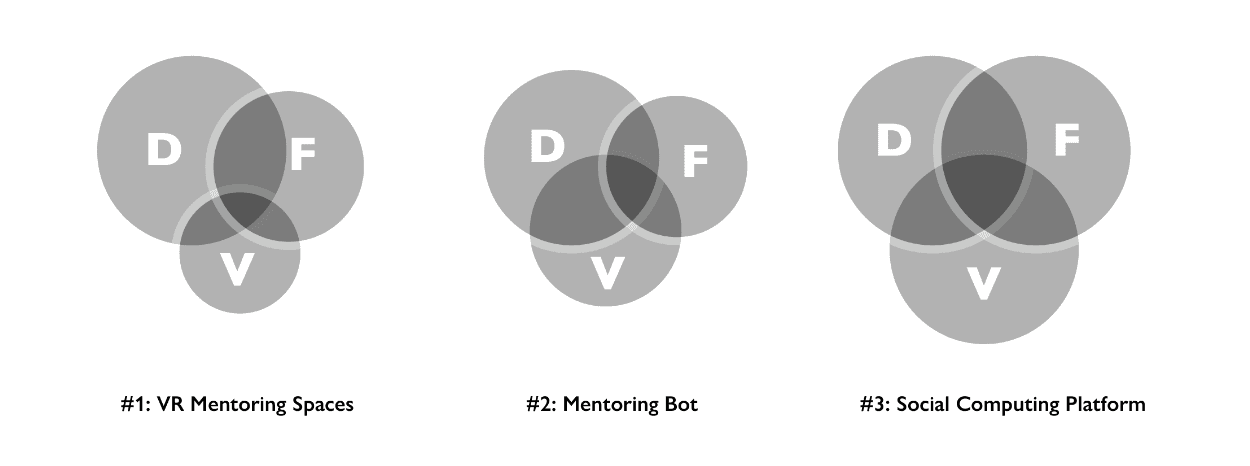
Value Proposition Matrix:
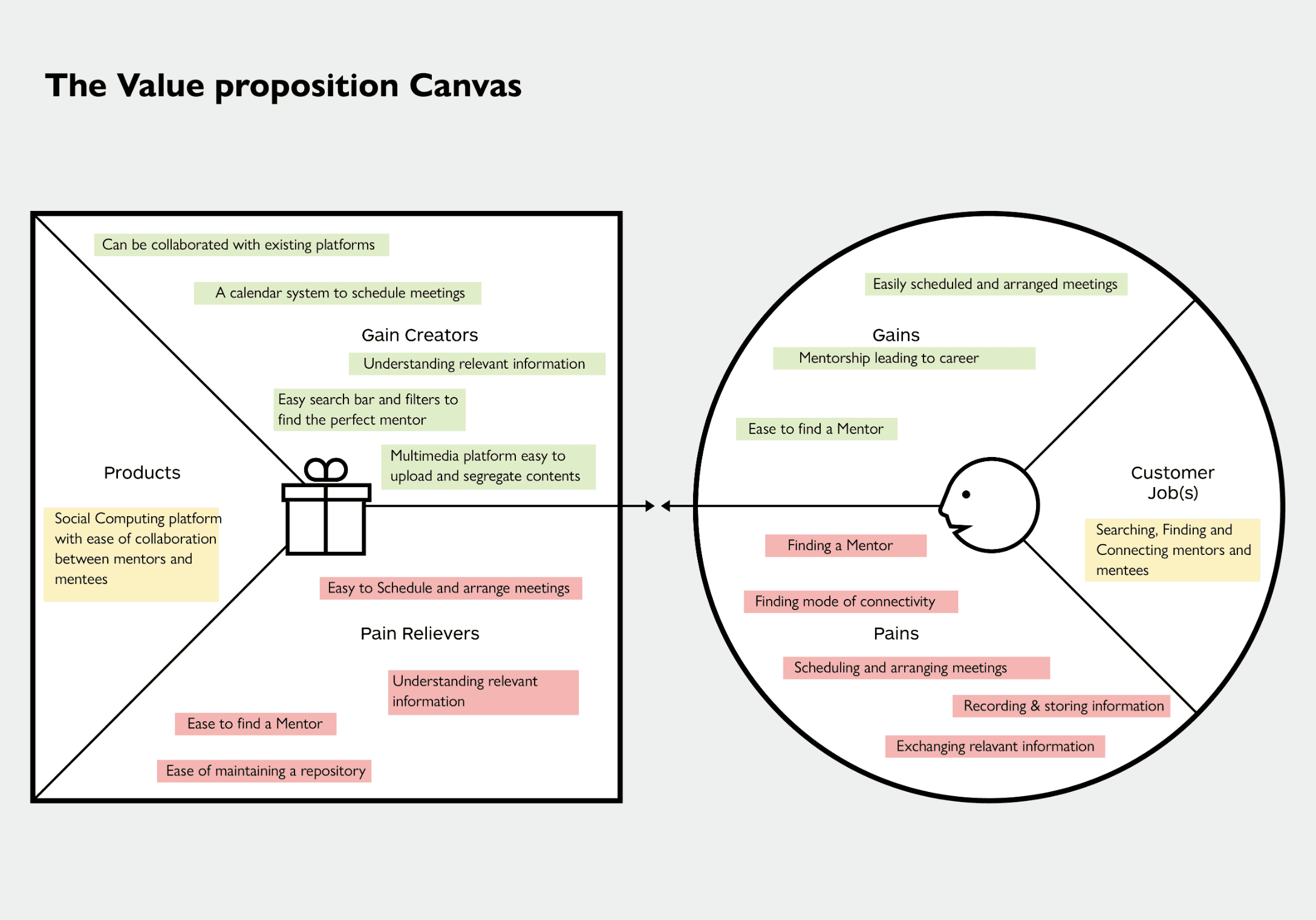
Final Design
We decided to go ahead with the Social computing platform. The platform will be designed to meet the mentoring, researching, and collaborating needs of the HCI student and industry professionals. The application will provide virtual mentoring, collaboration and knowledge sharing both live and in a large repository of content.
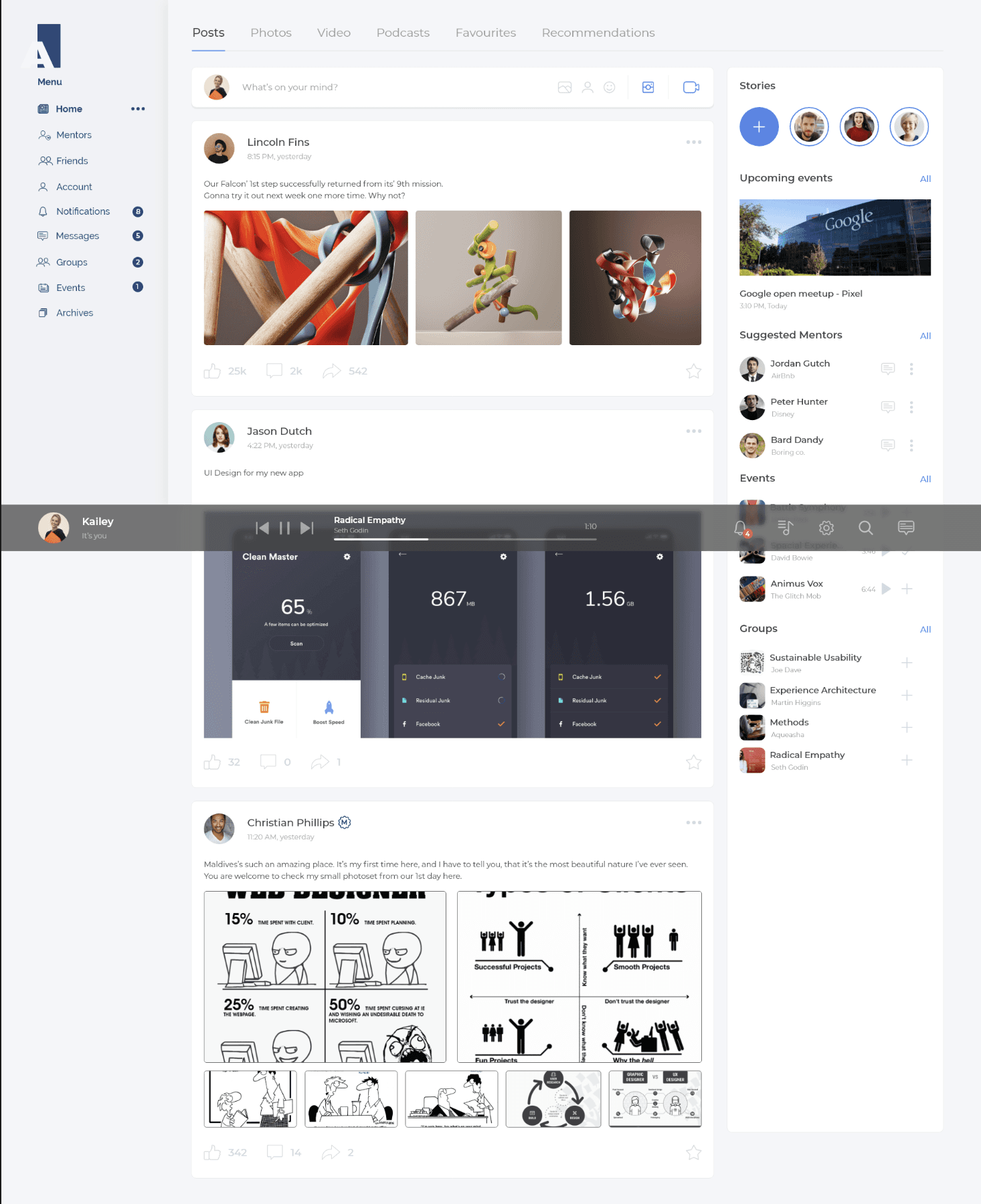
Feature-Validation
A website which can connect mentors and mentees.
1. Both individual and in groups. Mentors will have a mentor badge to differentiate their account.
2. Integration with LinkedIn
3. Live events where Mentees can enroll in. These events can even be hosted online by mentors connected through augMentor remotely.Students can post their questions as comments during the live event(sort of like a Twitch for webinars). The selected queries can be addressed and included in the discussion.
4. A repository of all the events and posts happened in the past. This can be managed by the mentors who would have the liberty to share/ control sharing of their content. The hierarchy of control will always lie with the mentor.
5. Groups managed by mentors to discuss specific topics.User-Flow
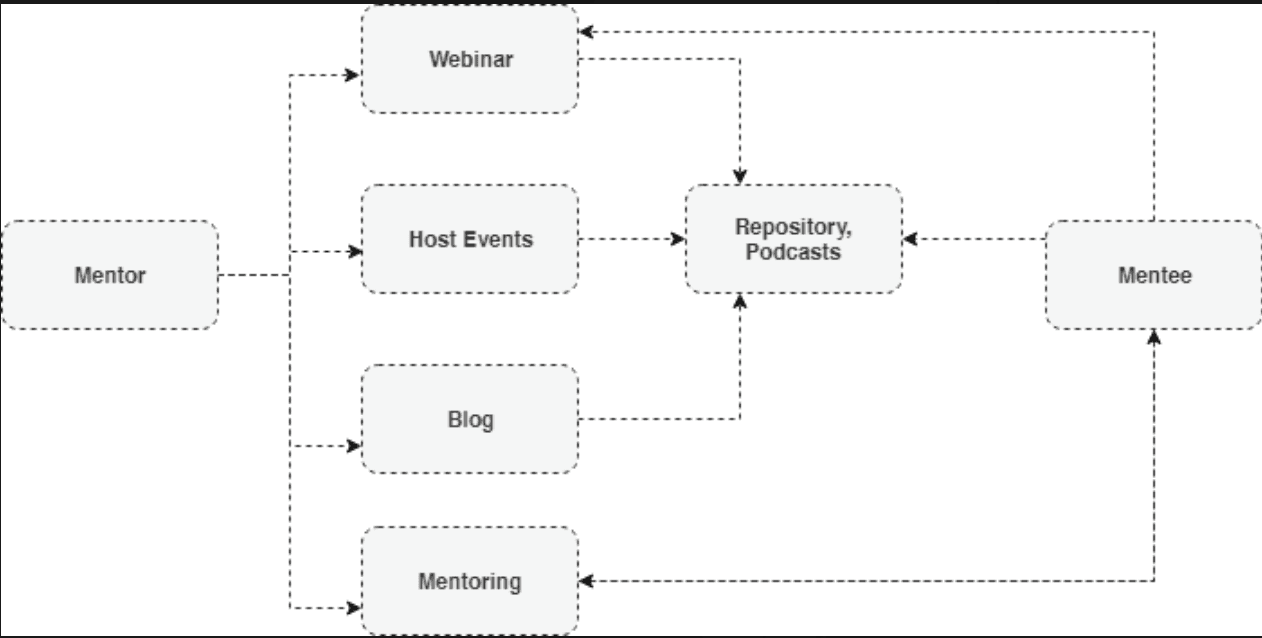
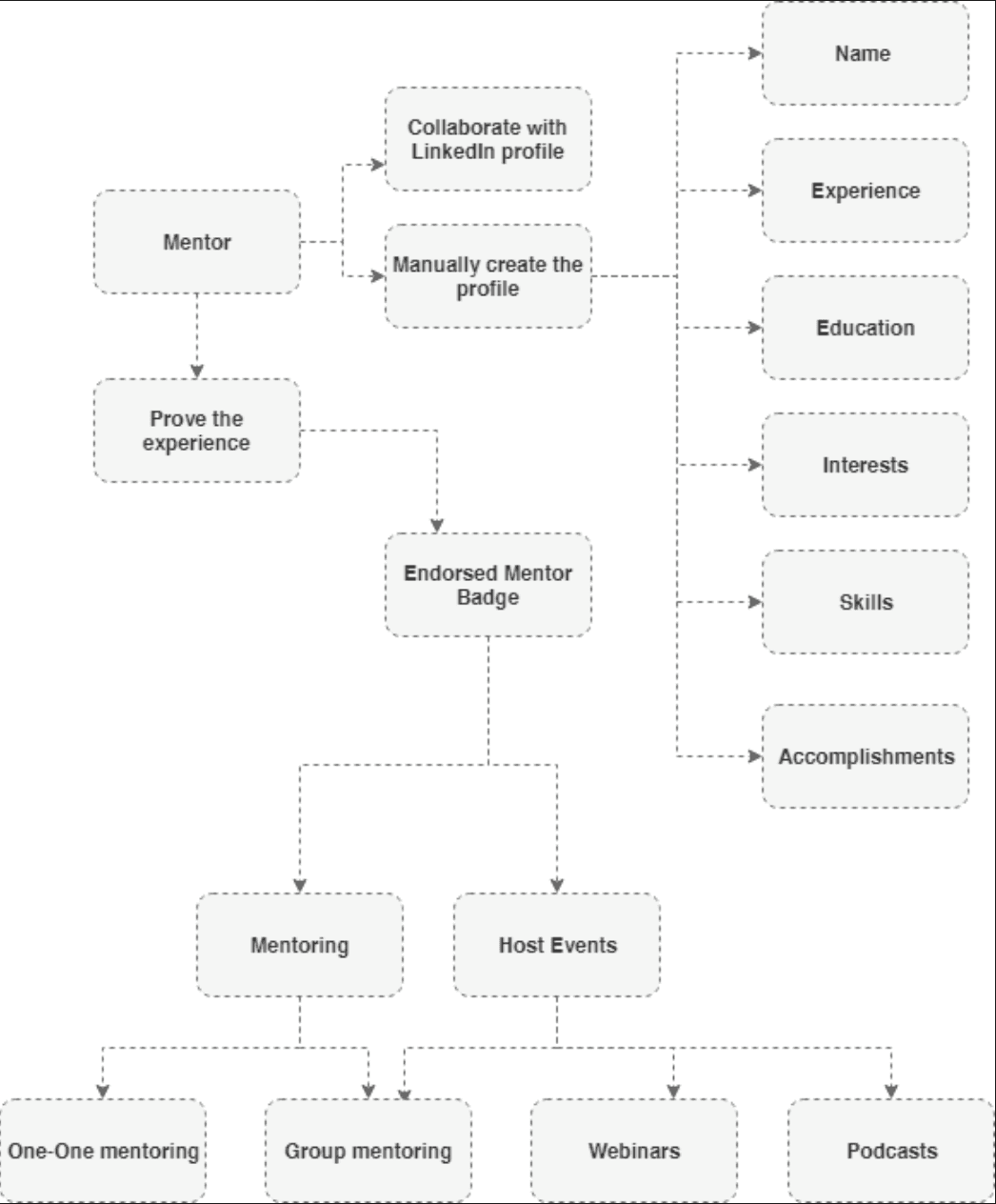
Wireframes
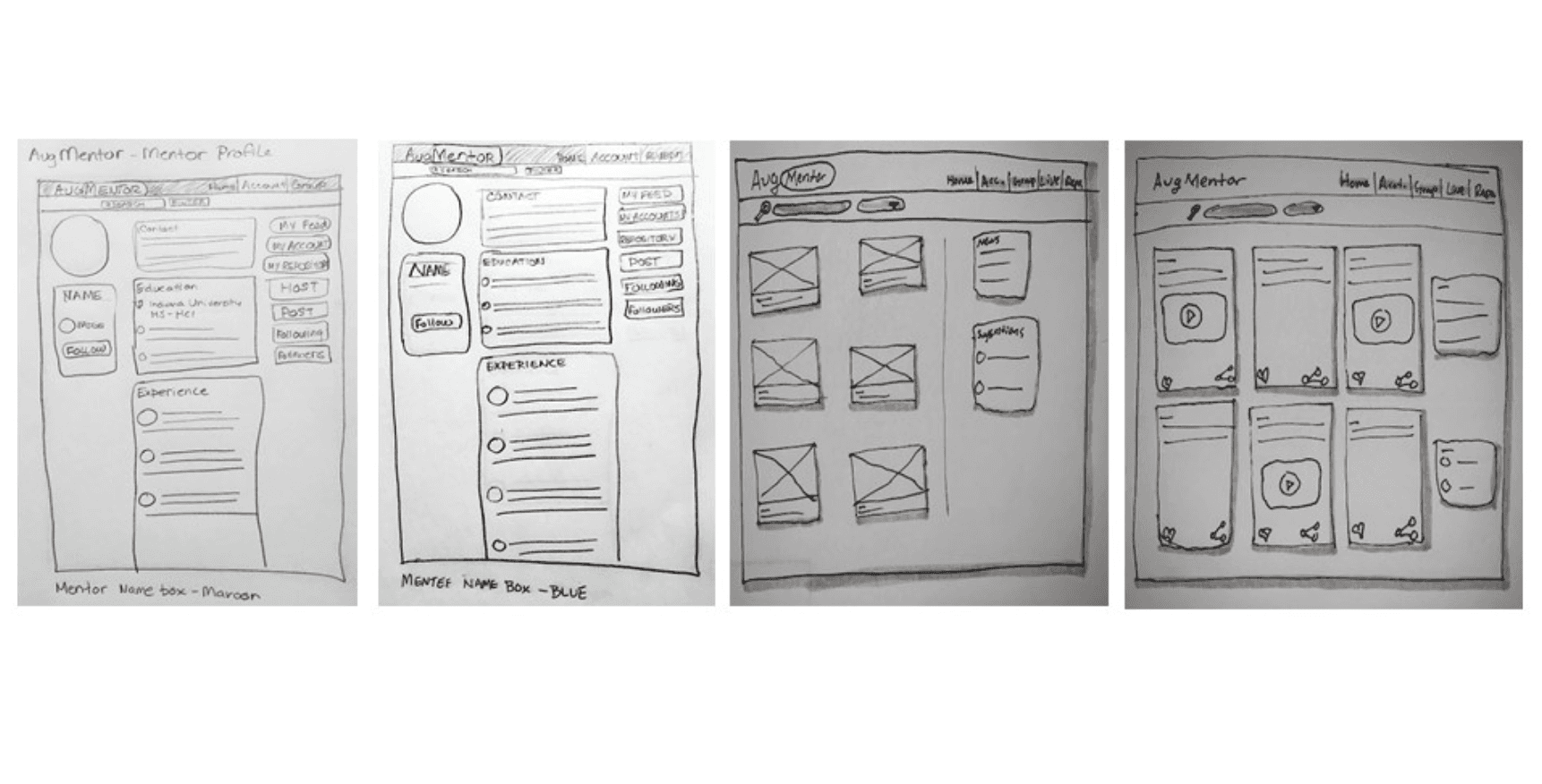




User Testing
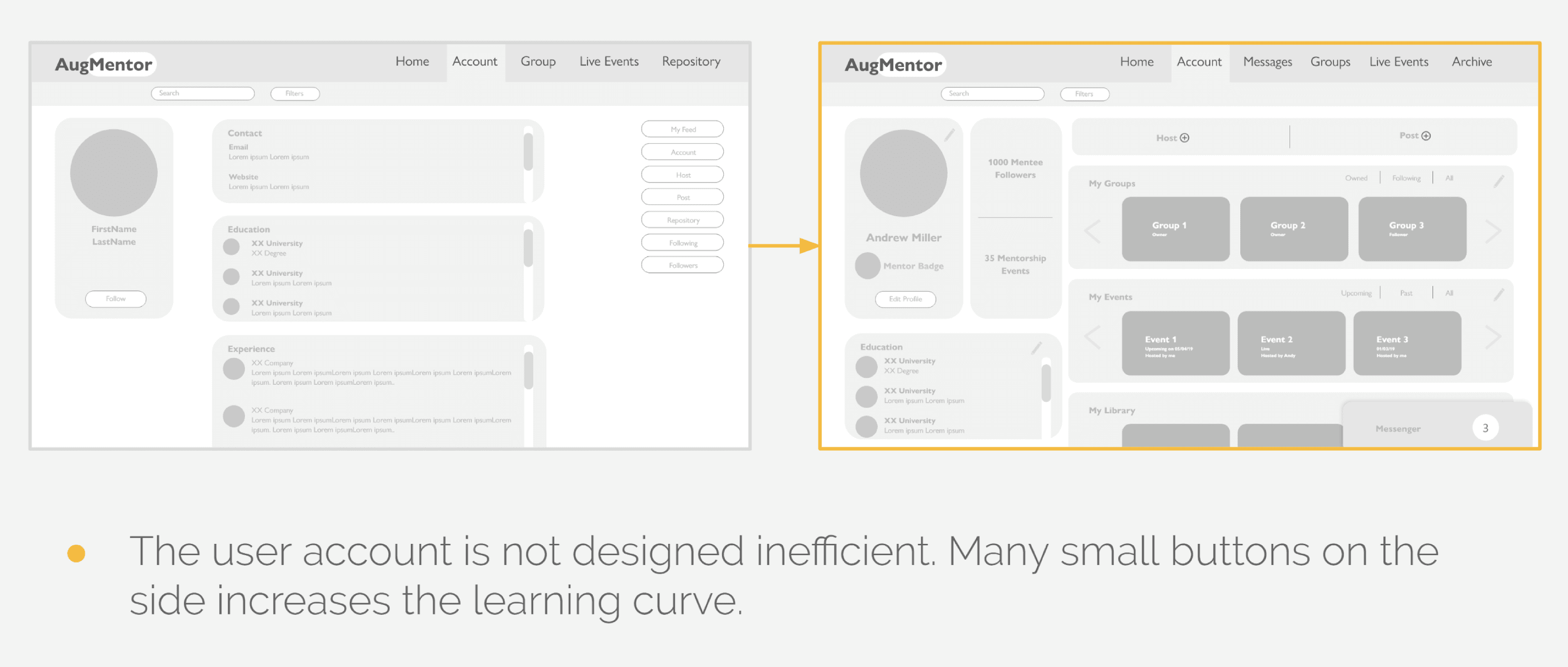


Updated Wireframe
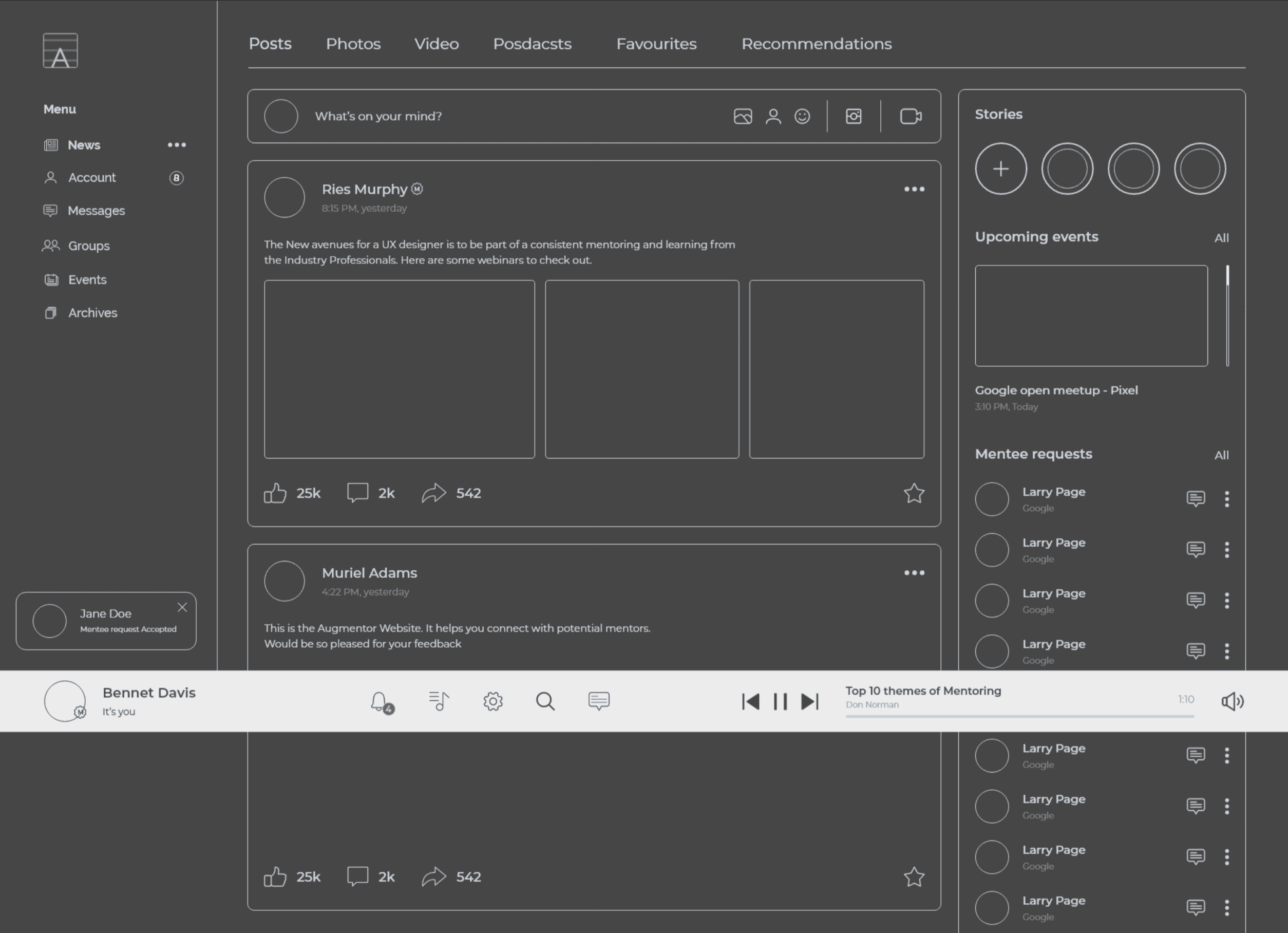
High Fidelity
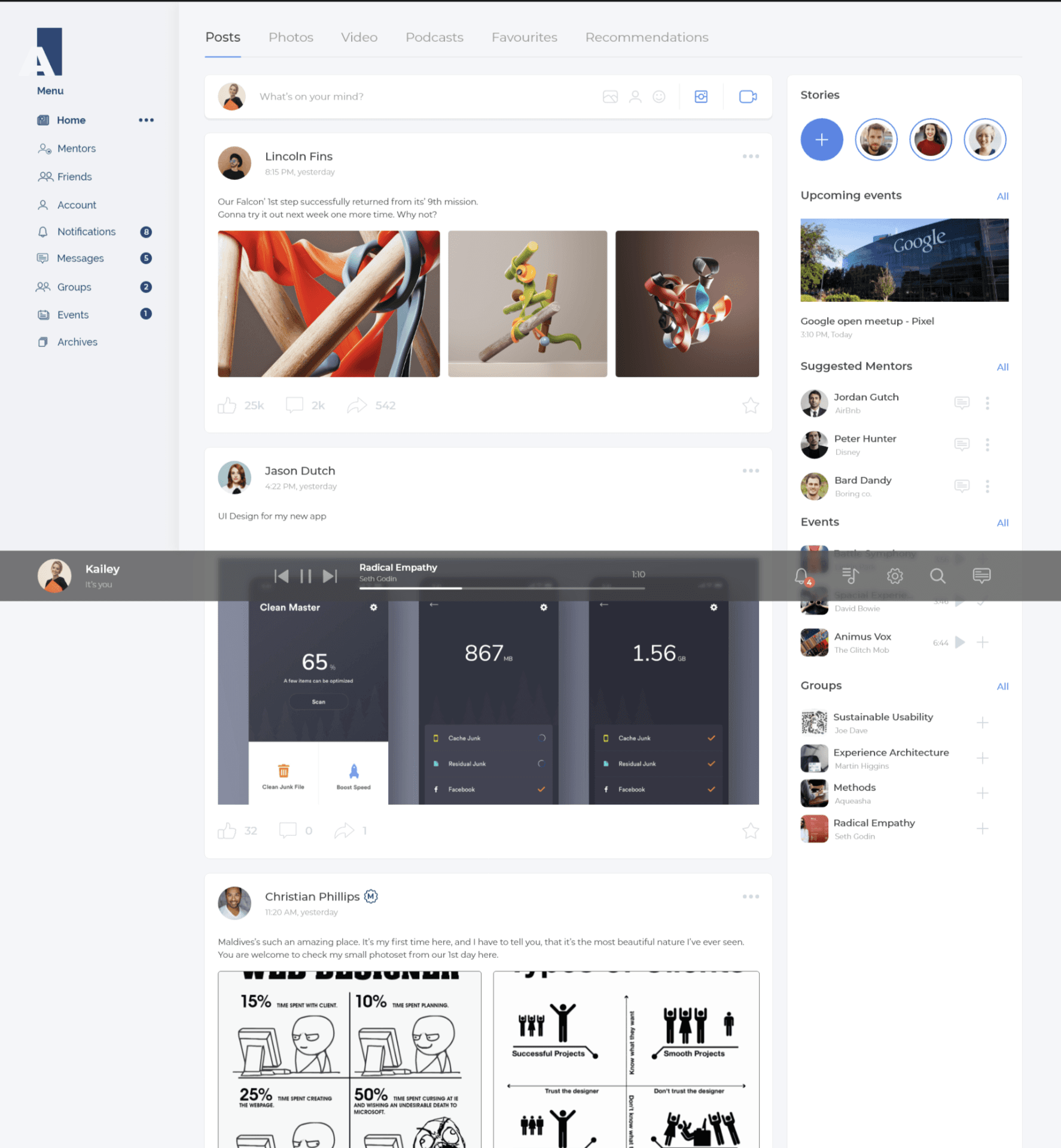

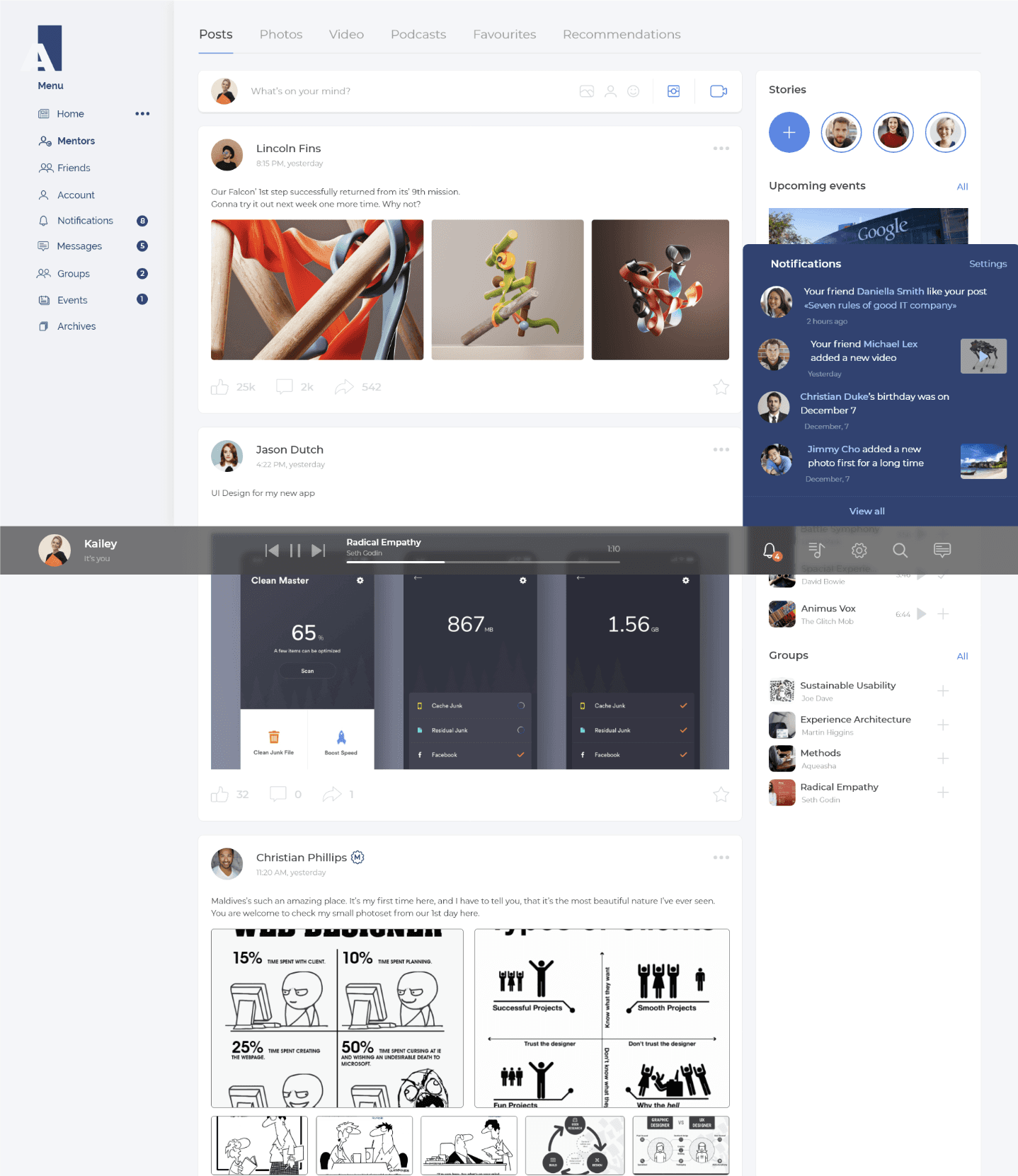
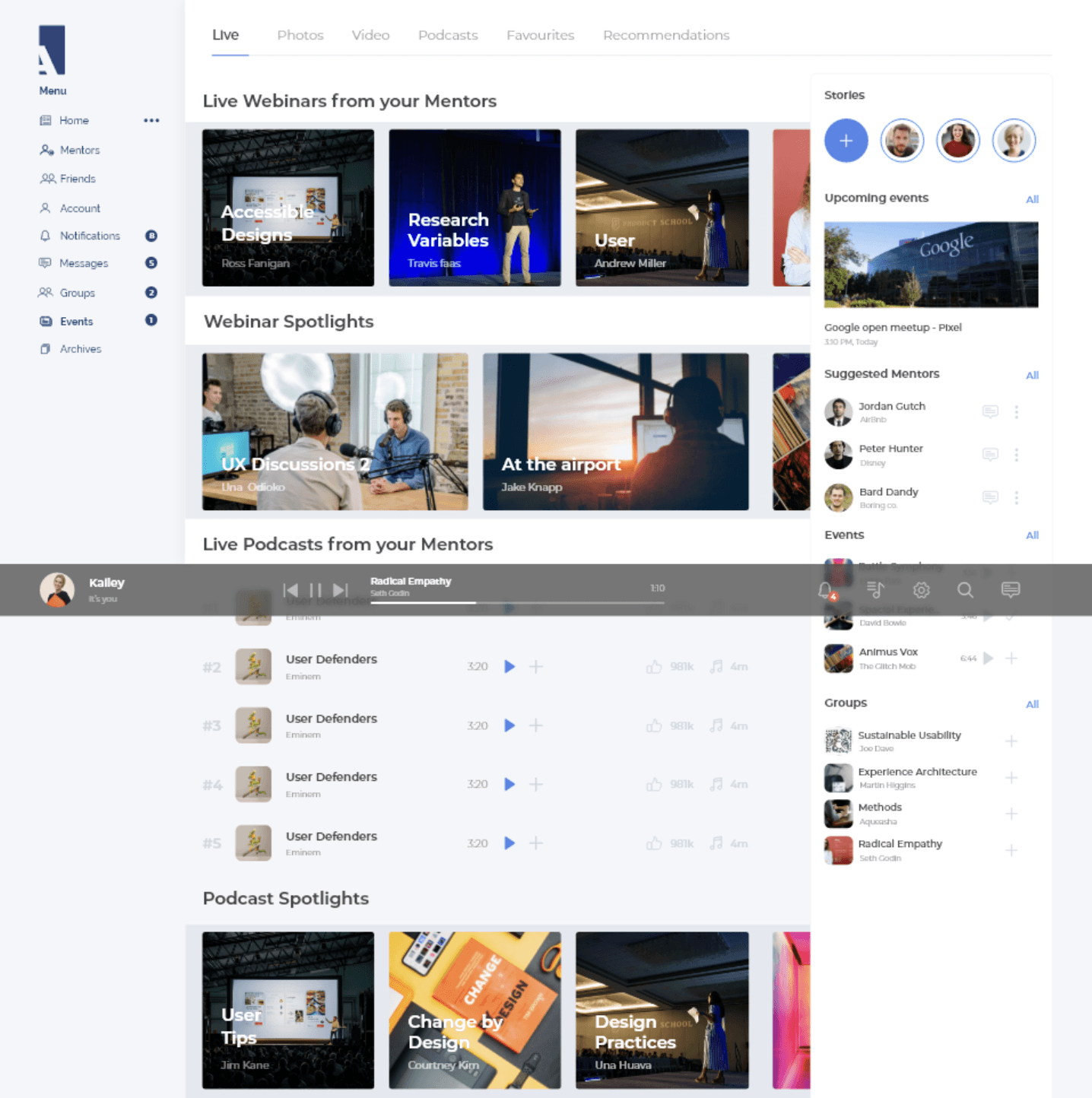
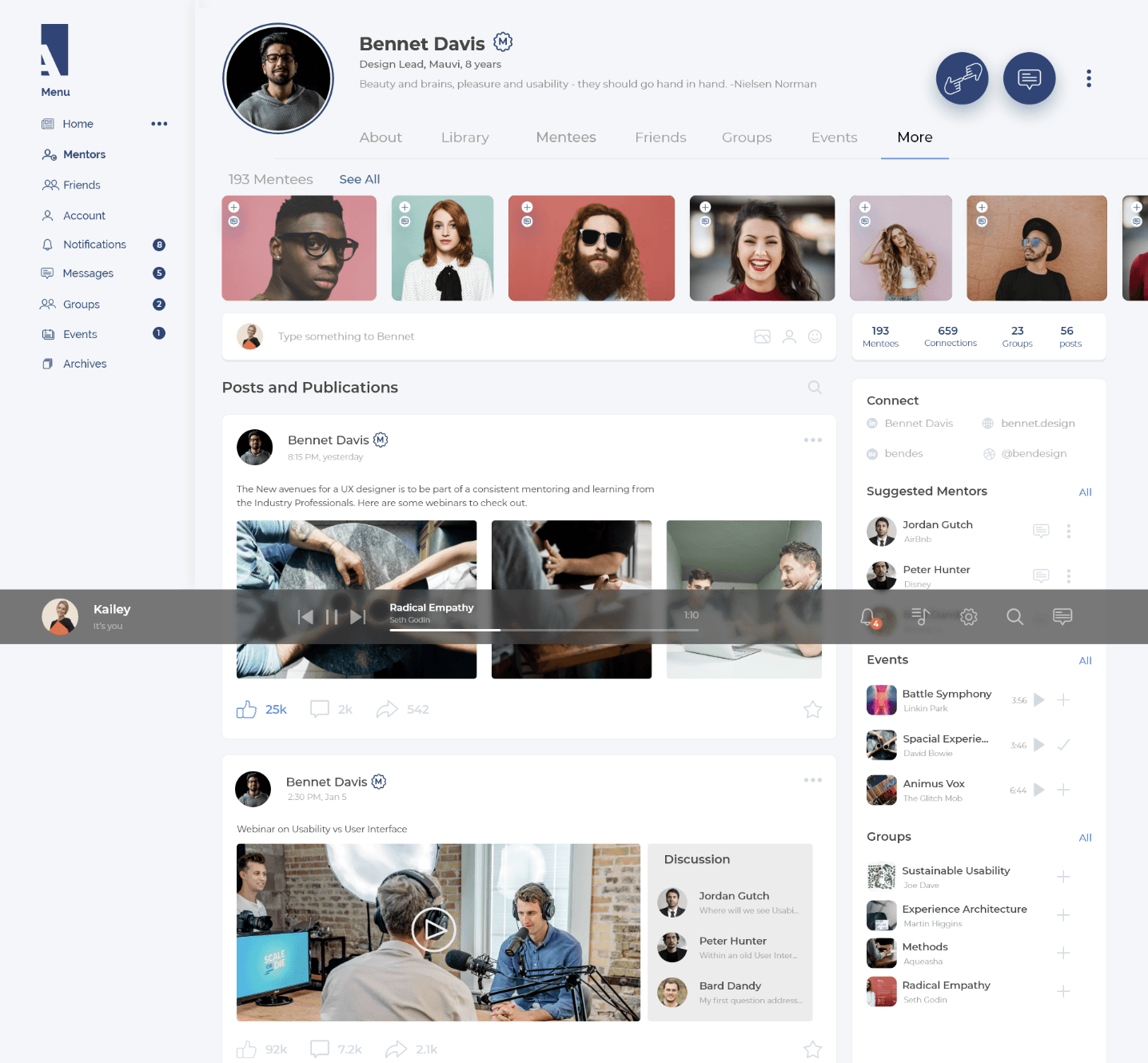
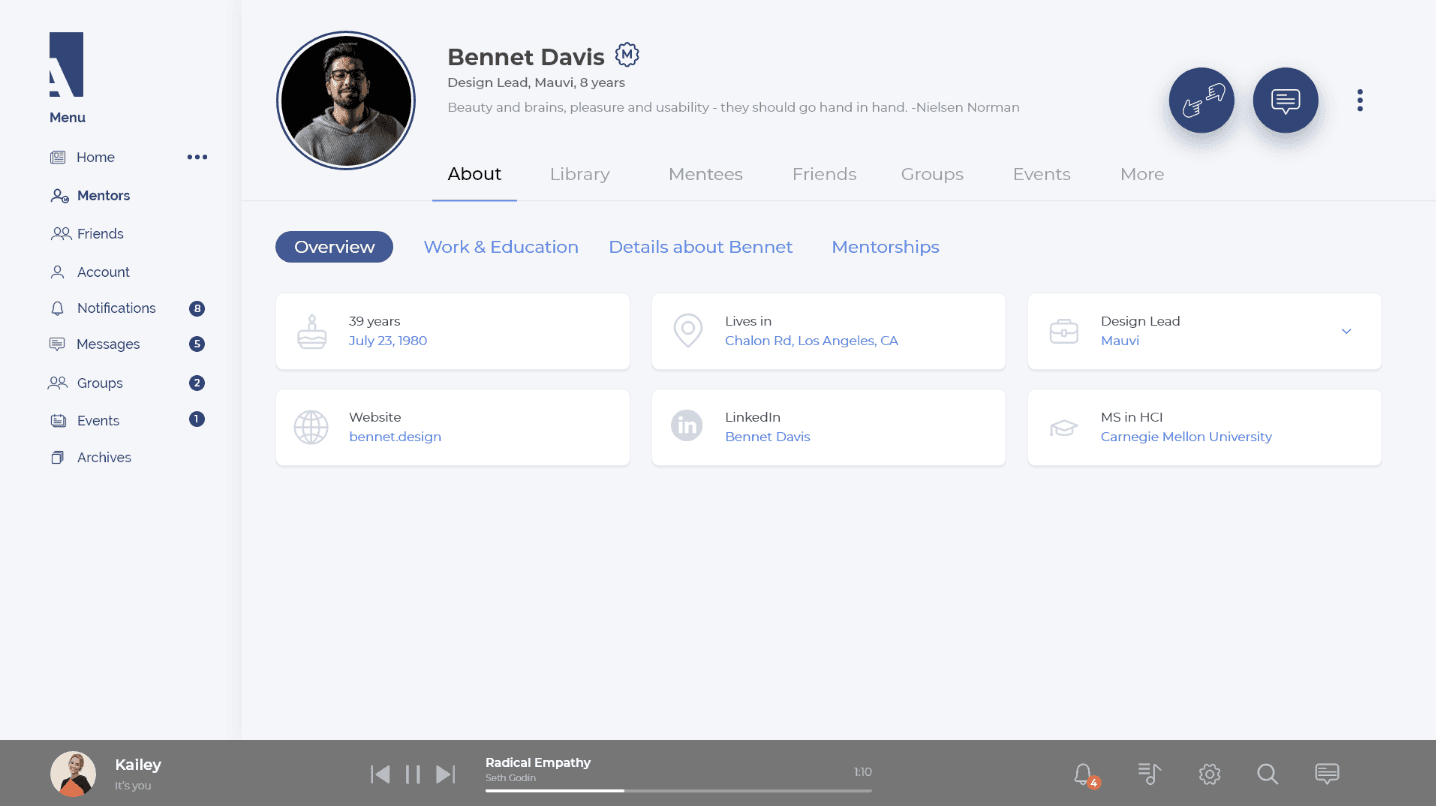
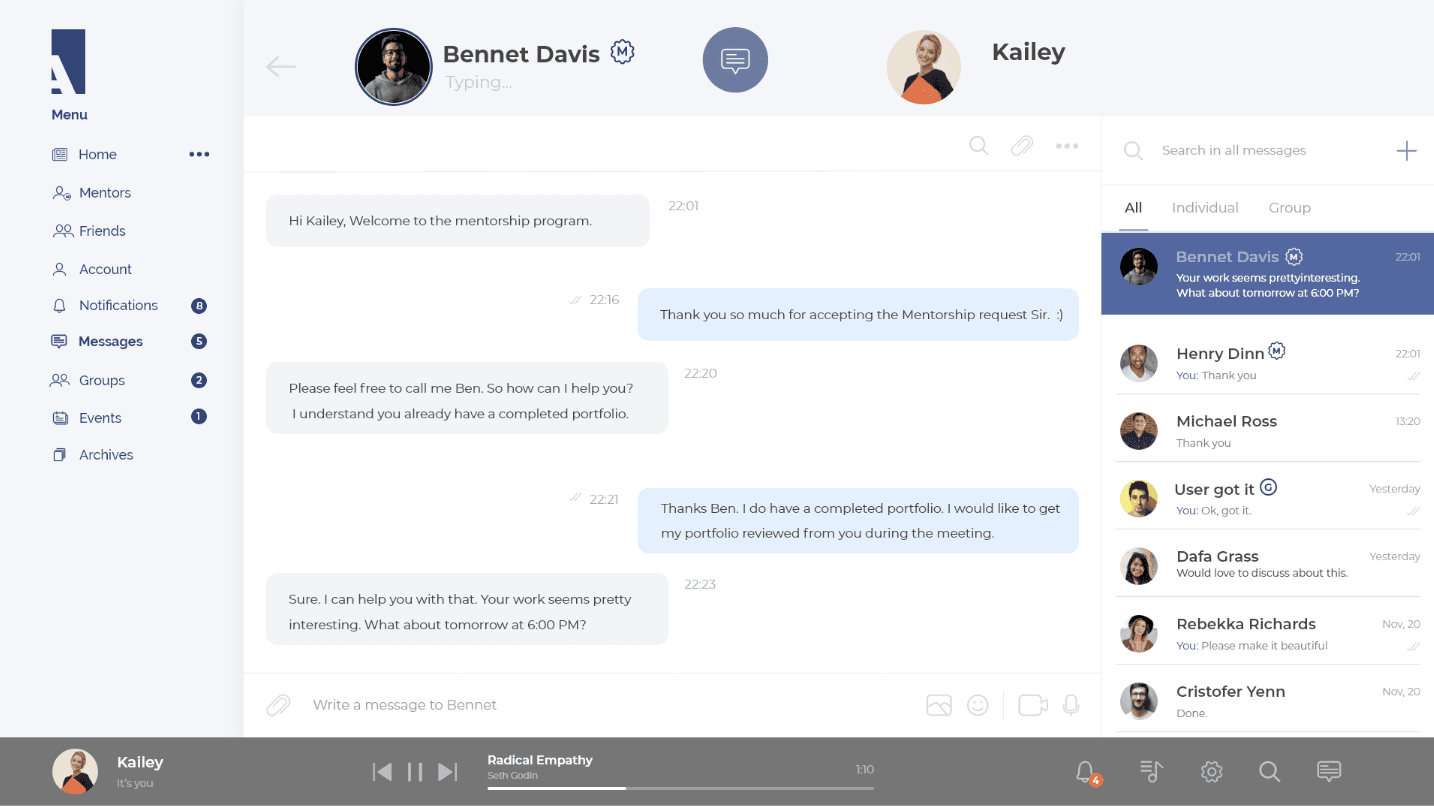
Reflections
This project helped me revisit the basics of product thinking, ideation, prototyping, and visual design in applications:
Paper Prototype: Enabled to quickly understanding the flow of the application and also enabled to perform rapid iterations in the beginning stages.
Storyboarding: Helped to understand the different scenarios in depth. Also, this eased the process of ideation.
Wireframing and multiple iterations: Again, rapid prototyping of the app for user testing. Ignoring visual aspects, in the beginning, enabled to concentrate solely on the functionality of the application that eventually eased the flow in the final iteration.
High Fidelity Prototype: Helped us to understand visual design and hierarchy of options for various options.
Experience Prototyping: The entire prototype helped me understand the design of an application as a reflection to the user and user needs. This approach facilitated the team to understand the prototype in a much deeper way which ultimately leads to a simplistic design at the end.
Understanding the User: A successful UX process is a reflection of satisfaction of users. Being an HCI student, I could place myself as user in majority of the scenarios of this design which helped me understand the design process better.
Overview
Human- Computer Interaction (HCI) areas of study have about 7000 students currently enrolled in the United States. The field has a wide variety of industry it touches and skill areas of specialization. With versatility comes different interpretations/jobs descriptions, skill sets, etc. where sharing of information is mandatory.
Roles: Primary Designer
Duration: 3 months
Team Designer: Enrico Banks, Amy Mansfield
We started by defining the problem space into a HMW statement:
How might we help connect aspiring students of HCI and young professionals with industry professionals for collaborative mentoring?
Process

How does mentorship happen on a national scale?

The current way of mentoring is not fulfilling all of the industry needs for good mentoring guidance and knowledge sharing without scheduling or geographic restraints among other barriers. In addition, with the vast amount of information fragmented throughout the website tides, it is important to have a comprehensive platform that compiles the needed information for the aspiring students as well as entry-level professionals to learn and prepare better. This not only does good for young professionals but also their future companies in the long-run.
One-to-One Mentoring
Group Mentoring
Training Based Mentoring
Research Process
Primary Research: Observation & Interviews
To analyze the current scenario of mentoring in the HCI world, we conducted observations and interviews with several mentors and mentees to get in-depth information about their pain points and experience in general.
Secondary Research: Literature Review
To understand the available technology and service to connect mentors & mentees, we started our process of gathering information from various sources to get familiar with the context.
Research Insights
a. Primary Research: Observation & Interviews
Mentors and mentees had various goals, frustrations, and expectations out of mentoring session. The following were thoroughly observed in each case we observed:
b.Secondary Research: Literature Review
Mentees:
1. Frustrations: Mentees with more contacts have better mentoring. But even in that situation, there is a limitation of mentorship
2. Concerns: Concern/ uncertain of the approach in many stages such as introduction, keeping professional information exchange a the primary goal of the session
3. Need: Mentorship is important for efficiency, a better understanding of the current trends, etc.
4. Expectations: Structured mentoring, Availability of Mentors, A collaborative repository to know the present trends
5. Motivations: Giveback, doing the right things
Mentors:
1. Frustration/ Taboo subjects: Mentees asking for a job on the first meet, Personal questions about their personal salary? There need to be an understanding of such taboo questions before the mentorship sessions begin
2. Concern: Time limitations for working mentors
3. Need: Industry-level buy-in
4. Expectation: Structure content & time-sharing, Mentees are expected to do their homework before the meeting
5. Motivation: Giveback, recruiting
Problem Synthesis
Drawing insights from the interviews, observations and literature reviews, we started the synthesis of the problem by creating personas and customer journey maps. This mapped various pain points which inevitably guided us to the solution in the later stages.
Mentee Persona:

Mentor Persona:

Mentee Journey Map:

Mentor Journey Map:

Identifying Pain points:
Mentees:

Mentors:

Prioritizing Pain Points
Given the limited time frame of the class project, we prioritized the pain points referencing it to the user statements where they stressed the most.The major pain points from mentee’s part were:
To analyze the current scenario of mentoring in the HCI world, we conducted observations and interviews with several mentors and mentees to get in-depth information about their pain points and experience in general.
1. Finding a Mentor/ mentorship
2. Confusion between the modes of connectivity
3. Scheduling and finding a perfect meeting spot
4. Recording and storing relevant information in different formats
The most pressing pain points from mentors were:
1. Dedicating time for mentorship
2. Connecting with mentees
3. Avoid taboo subjects(such as to request jobs/ referrals unexpectedly)
4. Curating and sharing the repository of information in any convenient format
Ideating the Solution
We started our ideation phase by brainstorming for various solutions that could fit in at different stages of the mentorship experience. The initial ideas were represented in the form of flowcharts and rough sketches.
Idea #1: Virtual Reality Mentoring Space

Pros
1. Could be initiated within Universities
2. Providing a surreal experience to the young professional
3. Ease of reaching out
Cons
1. High operational costs
2. Limited expandability
3. The mentor and the mentee requires specific equipment to meet both the endsIdea #2: Mentoring Bots

Pros
1. UniqueCost-Effective Solution
2. Ease of connectivity and accessibility
3. Can address/ point out taboo subjects to the mentees
Cons
1. Not really addressing the two-way interaction demanded by the stakeholders
2. Acts as a barrier rather than a conduit to mentoringIdea #3: Social Computing Platform

Pros
1. Connects mentors and mentees
2. Can collaborate with existing platforms
3. Scheduling and organizing meetings can be made easy
4. Can host online repository easy to share
5. Cost-effective
Cons
1. Takes time to expand and reach out
2. Has to keep in mind the privacy protection
7. Down Selection Process
Evaluating the pros and cons, my team and I went ahead with the social computing platform. Desirability, Viability & Feasibility matrix was used to evaluate and select the best option.
Desirability — Are We Solving for the Right Pain Points?
Feasibility — Are We Building on our Core Operational Strengths?
Viability — Does Our Solution Contribute to Long-Term Growth?

Value Proposition Matrix:

Final Design
We decided to go ahead with the Social computing platform. The platform will be designed to meet the mentoring, researching, and collaborating needs of the HCI student and industry professionals. The application will provide virtual mentoring, collaboration and knowledge sharing both live and in a large repository of content.

Feature-Validation
A website which can connect mentors and mentees.
1. Both individual and in groups. Mentors will have a mentor badge to differentiate their account.
2. Integration with LinkedIn
3. Live events where Mentees can enroll in. These events can even be hosted online by mentors connected through augMentor remotely.Students can post their questions as comments during the live event(sort of like a Twitch for webinars). The selected queries can be addressed and included in the discussion.
4. A repository of all the events and posts happened in the past. This can be managed by the mentors who would have the liberty to share/ control sharing of their content. The hierarchy of control will always lie with the mentor.
5. Groups managed by mentors to discuss specific topics.User-Flow


Wireframes





User Testing



Updated Wireframe

High Fidelity







Reflections
This project helped me revisit the basics of product thinking, ideation, prototyping, and visual design in applications:
Paper Prototype: Enabled to quickly understanding the flow of the application and also enabled to perform rapid iterations in the beginning stages.
Storyboarding: Helped to understand the different scenarios in depth. Also, this eased the process of ideation.
Wireframing and multiple iterations: Again, rapid prototyping of the app for user testing. Ignoring visual aspects, in the beginning, enabled to concentrate solely on the functionality of the application that eventually eased the flow in the final iteration.
High Fidelity Prototype: Helped us to understand visual design and hierarchy of options for various options.
Experience Prototyping: The entire prototype helped me understand the design of an application as a reflection to the user and user needs. This approach facilitated the team to understand the prototype in a much deeper way which ultimately leads to a simplistic design at the end.
Understanding the User: A successful UX process is a reflection of satisfaction of users. Being an HCI student, I could place myself as user in majority of the scenarios of this design which helped me understand the design process better.
Overview
Human- Computer Interaction (HCI) areas of study have about 7000 students currently enrolled in the United States. The field has a wide variety of industry it touches and skill areas of specialization. With versatility comes different interpretations/jobs descriptions, skill sets, etc. where sharing of information is mandatory.
Roles: Primary Designer
Duration: 3 months
Team Designer: Enrico Banks, Amy Mansfield
We started by defining the problem space into a HMW statement:
How might we help connect aspiring students of HCI and young professionals with industry professionals for collaborative mentoring?
Process

How does mentorship happen on a national scale?

The current way of mentoring is not fulfilling all of the industry needs for good mentoring guidance and knowledge sharing without scheduling or geographic restraints among other barriers. In addition, with the vast amount of information fragmented throughout the website tides, it is important to have a comprehensive platform that compiles the needed information for the aspiring students as well as entry-level professionals to learn and prepare better. This not only does good for young professionals but also their future companies in the long-run.
One-to-One Mentoring
Group Mentoring
Training Based Mentoring
Research Process
Primary Research: Observation & Interviews
To analyze the current scenario of mentoring in the HCI world, we conducted observations and interviews with several mentors and mentees to get in-depth information about their pain points and experience in general.
Secondary Research: Literature Review
To understand the available technology and service to connect mentors & mentees, we started our process of gathering information from various sources to get familiar with the context.
Research Insights
a. Primary Research: Observation & Interviews
Mentors and mentees had various goals, frustrations, and expectations out of mentoring session. The following were thoroughly observed in each case we observed:
b.Secondary Research: Literature Review
Mentees:
1. Frustrations: Mentees with more contacts have better mentoring. But even in that situation, there is a limitation of mentorship
2. Concerns: Concern/ uncertain of the approach in many stages such as introduction, keeping professional information exchange a the primary goal of the session
3. Need: Mentorship is important for efficiency, a better understanding of the current trends, etc.
4. Expectations: Structured mentoring, Availability of Mentors, A collaborative repository to know the present trends
5. Motivations: Giveback, doing the right things
Mentors:
1. Frustration/ Taboo subjects: Mentees asking for a job on the first meet, Personal questions about their personal salary? There need to be an understanding of such taboo questions before the mentorship sessions begin
2. Concern: Time limitations for working mentors
3. Need: Industry-level buy-in
4. Expectation: Structure content & time-sharing, Mentees are expected to do their homework before the meeting
5. Motivation: Giveback, recruiting
Problem Synthesis
Drawing insights from the interviews, observations and literature reviews, we started the synthesis of the problem by creating personas and customer journey maps. This mapped various pain points which inevitably guided us to the solution in the later stages.
Mentee Persona:

Mentor Persona:

Mentee Journey Map:

Mentor Journey Map:

Identifying Pain points:
Mentees:

Mentors:

Prioritizing Pain Points
Given the limited time frame of the class project, we prioritized the pain points referencing it to the user statements where they stressed the most.The major pain points from mentee’s part were:
To analyze the current scenario of mentoring in the HCI world, we conducted observations and interviews with several mentors and mentees to get in-depth information about their pain points and experience in general.
1. Finding a Mentor/ mentorship
2. Confusion between the modes of connectivity
3. Scheduling and finding a perfect meeting spot
4. Recording and storing relevant information in different formats
The most pressing pain points from mentors were:
1. Dedicating time for mentorship
2. Connecting with mentees
3. Avoid taboo subjects(such as to request jobs/ referrals unexpectedly)
4. Curating and sharing the repository of information in any convenient format
Ideating the Solution
We started our ideation phase by brainstorming for various solutions that could fit in at different stages of the mentorship experience. The initial ideas were represented in the form of flowcharts and rough sketches.
Idea #1: Virtual Reality Mentoring Space

Pros
1. Could be initiated within Universities
2. Providing a surreal experience to the young professional
3. Ease of reaching out
Cons
1. High operational costs
2. Limited expandability
3. The mentor and the mentee requires specific equipment to meet both the endsIdea #2: Mentoring Bots

Pros
1. UniqueCost-Effective Solution
2. Ease of connectivity and accessibility
3. Can address/ point out taboo subjects to the mentees
Cons
1. Not really addressing the two-way interaction demanded by the stakeholders
2. Acts as a barrier rather than a conduit to mentoringIdea #3: Social Computing Platform

Pros
1. Connects mentors and mentees
2. Can collaborate with existing platforms
3. Scheduling and organizing meetings can be made easy
4. Can host online repository easy to share
5. Cost-effective
Cons
1. Takes time to expand and reach out
2. Has to keep in mind the privacy protection
7. Down Selection Process
Evaluating the pros and cons, my team and I went ahead with the social computing platform. Desirability, Viability & Feasibility matrix was used to evaluate and select the best option.
Desirability — Are We Solving for the Right Pain Points?
Feasibility — Are We Building on our Core Operational Strengths?
Viability — Does Our Solution Contribute to Long-Term Growth?

Value Proposition Matrix:

Final Design
We decided to go ahead with the Social computing platform. The platform will be designed to meet the mentoring, researching, and collaborating needs of the HCI student and industry professionals. The application will provide virtual mentoring, collaboration and knowledge sharing both live and in a large repository of content.

Feature-Validation
A website which can connect mentors and mentees.
1. Both individual and in groups. Mentors will have a mentor badge to differentiate their account.
2. Integration with LinkedIn
3. Live events where Mentees can enroll in. These events can even be hosted online by mentors connected through augMentor remotely.Students can post their questions as comments during the live event(sort of like a Twitch for webinars). The selected queries can be addressed and included in the discussion.
4. A repository of all the events and posts happened in the past. This can be managed by the mentors who would have the liberty to share/ control sharing of their content. The hierarchy of control will always lie with the mentor.
5. Groups managed by mentors to discuss specific topics.User-Flow


Wireframes





User Testing



Updated Wireframe

High Fidelity







Reflections
This project helped me revisit the basics of product thinking, ideation, prototyping, and visual design in applications:
Paper Prototype: Enabled to quickly understanding the flow of the application and also enabled to perform rapid iterations in the beginning stages.
Storyboarding: Helped to understand the different scenarios in depth. Also, this eased the process of ideation.
Wireframing and multiple iterations: Again, rapid prototyping of the app for user testing. Ignoring visual aspects, in the beginning, enabled to concentrate solely on the functionality of the application that eventually eased the flow in the final iteration.
High Fidelity Prototype: Helped us to understand visual design and hierarchy of options for various options.
Experience Prototyping: The entire prototype helped me understand the design of an application as a reflection to the user and user needs. This approach facilitated the team to understand the prototype in a much deeper way which ultimately leads to a simplistic design at the end.
Understanding the User: A successful UX process is a reflection of satisfaction of users. Being an HCI student, I could place myself as user in majority of the scenarios of this design which helped me understand the design process better.
